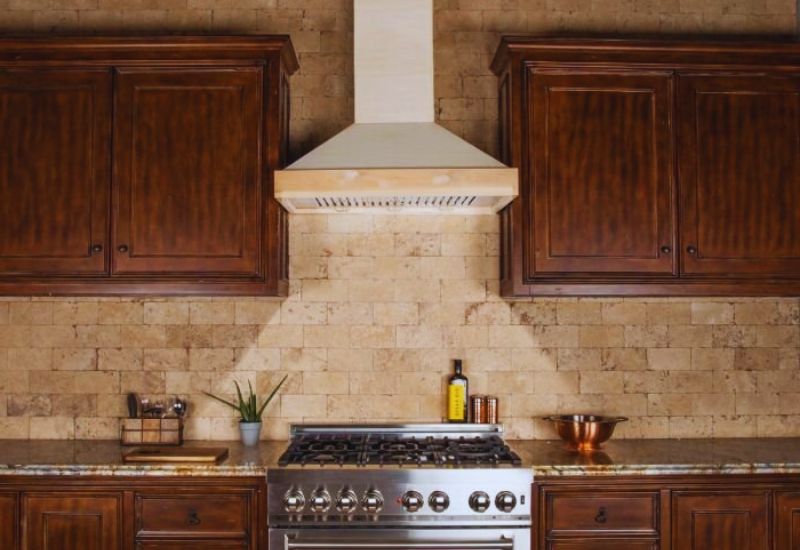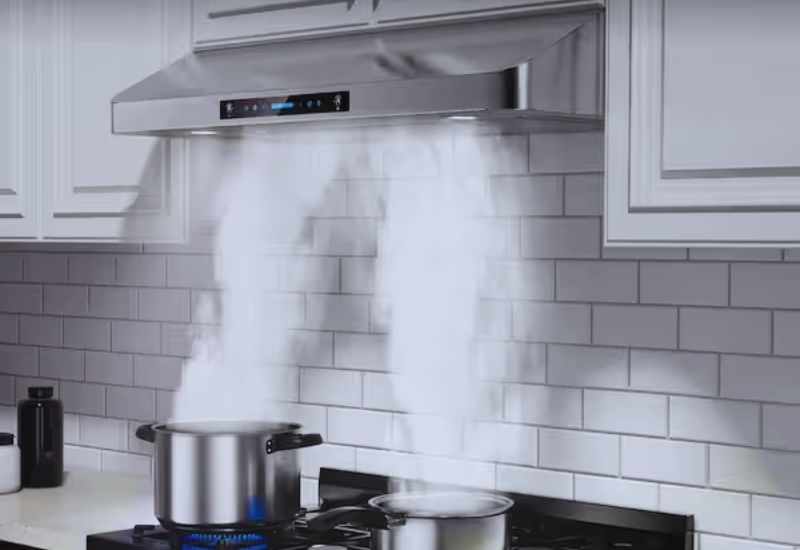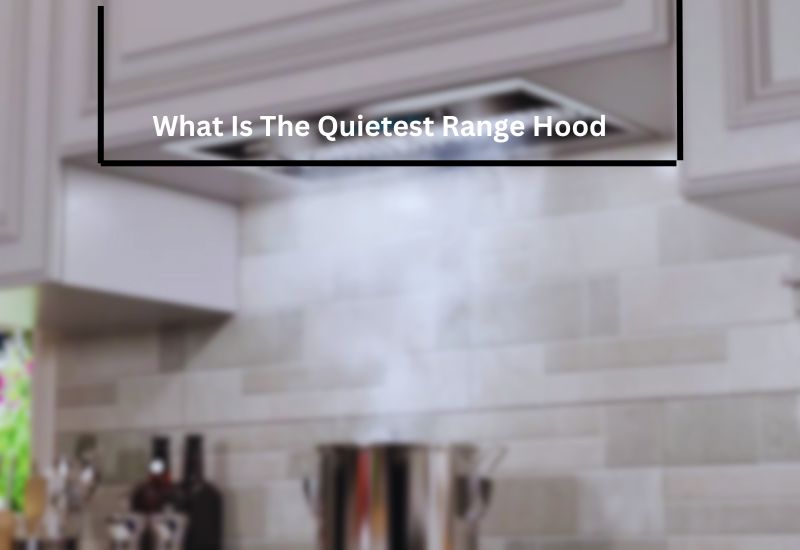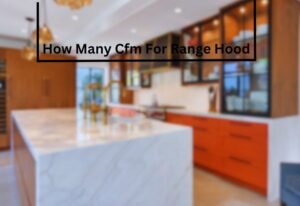Introducing the concept of a “quietest range hood,” a kitchen essential that’s often overlooked but can significantly impact your cooking experience. Imagine a range hood that efficiently clears away cooking odors and smoke while operating so quietly that you hardly notice it’s there.
What Is The Quietest Range Hood? The Quietest Range Hood would typically be one with a low sone rating (measuring noise levels). Look for hoods with advanced sound insulation, efficient fan design, and variable speed settings to minimize noise. Additionally, consider models with a “silent” or “quiet mode” for quieter operation
In this exploration, we delve into the world of silent kitchen ventilation, uncovering the benefits it offers for a peaceful cooking environment. We’ll discuss the technology behind these hoods, their features, and how they contribute to maintaining a serene atmosphere in your home. Whether you’re a seasoned chef or just enjoy whipping up simple meals, discovering the quietest range hood could be the key to a more enjoyable and tranquil culinary journey.
Understanding Quietest Range Hoods: Exploring Noise Reduction Technology

In modern kitchens, range hoods play a crucial role in maintaining a clean and odor-free cooking environment. However, traditional range hoods often come with an unwanted downside – noise.
The clattering and whirring sounds generated by conventional range hoods can be a significant source of annoyance, leading to a demand for quieter alternatives. This has prompted the development and integration of noise reduction technology in range hoods, ensuring a more peaceful culinary experience for homeowners.
The Challenge of Noise in Range Hoods:
Noise has long been a drawback of many kitchen appliances, including range hoods. The powerful motors required to effectively eliminate smoke, steam, and odors can produce a considerable amount of noise.
This has led to the pursuit of innovative solutions to address this issue, resulting in the emergence of quieter range hood models.
Noise Reduction Technology: Exploring the Mechanisms:
Noise reduction technology in range hoods encompasses a range of approaches aimed at minimizing the sound produced during operation. One key method involves the use of sound-absorbing materials in the construction of the range hood.
These materials are strategically placed to dampen the vibrations and sound waves generated by the motor and airflow. Additionally, advancements in motor design and aerodynamics have led to the development of more efficient and quieter fan systems.
Variable Speed Settings and Quiet Mode:
Manufacturers have recognized the importance of providing users with control over noise levels. Many modern range hoods now come equipped with variable speed settings. This feature enables users to adjust the fan’s speed according to the cooking task at hand, striking a balance between efficient ventilation and noise reduction.
Furthermore, several models feature a “quiet mode” specifically designed for minimal noise production during light cooking activities or times when a serene kitchen ambiance is desired.
Smart Technology Integration:
The advent of smart technology has extended to kitchen appliances, including range hoods. Smart range hoods often include noise reduction features that can be controlled remotely through smartphone apps or integrated into home automation systems.
These advanced models allow users to conveniently manage noise levels and ventilation performance, enhancing the overall cooking experience.
Considerations When Choosing a Quiet Range Hood:
When selecting a quiet range hood, several factors come into play. These include the size and layout of your kitchen, the cooking methods you frequently use, and the noise tolerance level of your household. It’s advisable to check the decibel rating of the range hood, which indicates its noise output.
Additionally, reading user reviews and seeking expert opinions can provide valuable insights into the real-world performance of a specific model’s noise reduction technology.
Importance of a Quiet Kitchen: How Silent Range Hoods Make a Difference

In the modern culinary landscape, the kitchen has evolved into not just a space for cooking, but also a hub for socializing and relaxation. Amidst this transformation, the significance of a quiet kitchen has gained prominence, prompting homeowners and designers to invest in appliances that contribute to a tranquil environment.
One such appliance that plays a crucial role in maintaining kitchen serenity is the silent range hood. With its advanced technology and seamless functionality, a silent range hood offers several benefits that extend beyond mere noise reduction.
Enhanced Cooking Experience
A peaceful cooking experience can significantly impact the quality of your meals. Traditional range hoods often produce loud and intrusive noises, disrupting the cooking process and making it difficult to communicate with others.
In contrast, silent range hoods operate almost imperceptibly, allowing you to concentrate on your culinary endeavors without unnecessary distractions. Whether you’re finely chopping ingredients or simmering a delicate sauce, the absence of noise interference promotes precision and focus, resulting in more satisfying dishes.
Promotion of Social Interaction
Kitchens have become spaces for bonding and shared experiences. Family members and friends often gather around while meals are prepared, turning cooking into a collaborative and enjoyable activity.
Excessive noise from a range hood can hinder conversations and create a strained atmosphere. A quiet range hood, however, encourages seamless interactions, enabling you to engage with your loved ones while cooking. This fosters a sense of togetherness and turns the kitchen into a lively and inviting space.
Preservation of Tranquility
In homes with open floor plans, noise easily travels from one room to another, disrupting the overall ambiance. A noisy range hood can disturb the tranquility of adjacent spaces, making it challenging to create an oasis of calm in your home.
Silent range hoods operate discreetly, ensuring that the peaceful atmosphere you’ve cultivated in your living areas remains undisturbed. This is particularly valuable in residences where the kitchen is integrated into the larger living or dining space.
Aesthetic Elegance and Integration
Beyond functionality, the visual appeal of a kitchen is equally important. Traditional range hoods, often bulky and obtrusive, can detract from the kitchen’s aesthetic. Silent range hoods, however, are designed with sleekness and minimalism in mind.
They seamlessly integrate into various kitchen styles, from contemporary to traditional, contributing to a harmonious visual composition. The absence of protruding vents and noisy fan systems elevates the overall elegance of the kitchen, making it a space that’s both functional and visually pleasing.
Health and Well-being
Noise pollution has been linked to various health concerns, including stress, sleep disturbances, and cognitive impairment. Prolonged exposure to loud kitchen noises can lead to heightened stress levels and a compromised sense of well-being. By opting for a silent range hood, you actively prioritize your health and that of your family members.
Reduced noise levels in the kitchen contribute to a more peaceful living environment, promoting relaxation and enhancing overall quality of life.
Comparing Decibel Levels: Finding the Balance Between Performance and Noise

In today’s fast-paced and technologically driven world, the pursuit of optimal performance often goes hand in hand with managing the accompanying noise levels.
From industrial machinery to household appliances, the measurement of sound intensity is quantified in decibels (dB), providing a crucial metric to evaluate the balance between performance and the auditory environment. Understanding the implications of decibel levels is essential for ensuring both efficient operations and a comfortable living or working atmosphere.
The Science Behind Decibels: A Primer
Decibels are a logarithmic unit used to express the ratio between two values, often of power or intensity. Due to the logarithmic nature of this scale, every 10 dB increase corresponds to a tenfold increase in sound intensity. This means that a sound at 70 dB is actually ten times more intense than a sound at 60 dB.
This scale is particularly useful when comparing a wide range of sound levels, from the faintest whispers to the loudest roars.
Performance and Noise: Striking the Right Balance
In various scenarios, such as industrial settings, the focus is on optimizing performance while minimizing excessive noise. Machinery used in manufacturing, construction, and transportation can generate high decibel levels that not only pose a threat to workers’ hearing health but can also disrupt surrounding communities.
Engineers and manufacturers often strive to find the right balance between equipment efficiency and noise control, employing techniques like vibration isolation, soundproofing, and improved design to achieve quieter operations.
Everyday Life: Domestic Applications of Decibel Knowledge
Beyond the industrial landscape, understanding decibels also plays a pivotal role in managing noise within our homes. Common household appliances like vacuum cleaners, blenders, and air conditioning units can contribute to the overall acoustic environment.
For instance, when choosing appliances, consumers can refer to decibel ratings to select quieter options, thus maintaining a more peaceful living space. This knowledge empowers individuals to make informed decisions that align with their preferences for comfort and convenience.
Entertainment and Safe Listening Practices
Decibel awareness extends to the realm of entertainment as well, especially when it comes to music and events. Concerts, clubs, and personal listening devices have sparked discussions about hearing health and noise-induced hearing loss.
Musicians, sound engineers, and event organizers now pay careful attention to the volume levels at venues to ensure both an electrifying experience and the safety of attendees’ hearing. This awareness underscores the importance of adopting safe listening practices and using protective gear like earplugs when attending loud events.
Regulations and Standards: Legal Framework for Noise Control
Recognizing the potential health hazards posed by excessive noise, governments and organizations have implemented regulations to enforce acceptable noise levels in various settings.
These regulations often outline permissible decibel levels for different environments, ensuring the well-being of workers, residents, and the general public. Compliance with these standards not only safeguards hearing but also contributes to overall community harmony.
Innovations in Soundproofing: Advances in Quieting Modern Range Hoods

In recent years, the pursuit of quieter and more efficient kitchen appliances has led to remarkable innovations in soundproofing, particularly in the realm of range hoods. These essential kitchen fixtures are designed not only to ventilate cooking spaces but also to combat the noise generated by powerful exhaust systems.
Engineers and designers have been working tirelessly to develop advanced soundproofing techniques that mitigate the disruptive noise generated by range hoods, creating a more pleasant and serene cooking environment for homeowners.
. Multi-Layer Insulation:
One of the prominent innovations in soundproofing modern range hoods involves the integration of multi-layer insulation. Traditionally, range hoods were constructed with a single layer of metal or plastic, which allowed sound vibrations to easily propagate.
However, the introduction of multi-layer insulation, which typically includes materials like acoustic foam, mineral wool, and vibration-damping coatings, has significantly reduced the transmission of sound waves. These layers work synergistically to absorb and dampen sound, thereby preventing it from escaping into the kitchen and beyond.
Airflow Optimization:
Advances in aerodynamics and airflow analysis have also contributed to quieter range hoods. Engineers now employ computational fluid dynamics (CFD) simulations to refine the design of hoods and ducts.
By optimizing the airflow path, turbulence and the resulting noise can be minimized. Smooth airflow not only improves the range hood’s efficiency but also helps in reducing the noise caused by air resistance and turbulence within the system.
Brushless DC Motors:
The adoption of brushless DC (BLDC) motors is another groundbreaking development in soundproofing range hoods.
These motors offer enhanced precision in controlling fan speed and airflow while significantly reducing mechanical noise. Unlike traditional brushed motors, BLDC motors generate less friction and vibration, resulting in quieter operation. Furthermore, these motors are more energy-efficient, contributing to the overall sustainability of modern range hoods.
Active Noise Cancellation:
Inspired by noise-cancelling technology used in headphones, active noise cancellation (ANC) systems are making their way into range hood design. These systems employ microphones to detect the sound emitted by the range hood and then generate inverse sound waves to cancel out the noise.
While still relatively new in the kitchen appliance arena, ANC holds immense potential to provide a customizable and dynamic approach to noise reduction.
Smart Sensor Integration:
The integration of smart sensors adds another dimension to the quest for quieter range hoods. By monitoring factors such as cooking intensity, temperature, and humidity, these sensors can adjust the fan speed and operation mode in real time. This not only minimizes noise levels when it’s not necessary to operate at maximum capacity but also optimizes ventilation efficiency. As a result, homeowners can enjoy a quieter cooking environment without compromising on performance.
Choosing Materials for Noise Reduction: Impact of Design and Construction

In the realm of architectural and interior design, noise reduction has emerged as a pivotal consideration, particularly in urban environments where noise pollution can be a significant concern. The choice of materials used in construction plays a crucial role in determining the effectiveness of noise reduction strategies.
Architects and designers are now focusing on integrating materials that not only enhance the aesthetics of a space but also contribute to a quieter and more serene environment.
Acoustical Properties of Materials: A Foundation for Quiet Spaces
When selecting materials for noise reduction, it is imperative to understand the acoustical properties of different options. Materials with high sound absorption coefficients, such as acoustic ceiling panels, fabric-covered wall panels, and open-cell foams, are essential for minimizing sound reflections and echoes.
Additionally, mass-loaded vinyl, cork, and specialized acoustic drywall can be used to block or dampen airborne sound, ensuring a more peaceful ambiance. An informed selection of these materials serves as the bedrock for effective noise reduction.
Beyond Aesthetics: The Functional Beauty of Soft Materials
Soft materials, often underappreciated for their role in design, can significantly contribute to noise reduction. Carpets, for instance, not only add warmth and comfort to a space but also help absorb sound, particularly in high-traffic areas.
The texture and composition of curtains and drapes make them valuable assets in noise reduction strategies as they can absorb and diffuse sound waves. Integrating these soft materials thoughtfully into the design not only enhances the visual appeal but also optimizes the acoustic environment.
Structural Elements as Sound Barriers
An often overlooked aspect of noise reduction is the strategic use of structural elements. Incorporating dense materials, such as concrete and brick, into the building’s structure can create an effective sound barrier, minimizing the penetration of external noise.
Double-glazed windows, with their layered construction, also play a significant role in reducing sound transmission while maintaining visual transparency. Proper placement and installation of these elements are crucial to ensure their maximum noise-reducing potential.
Innovative Solutions: Technology Meets Tranquility
Advancements in technology have opened doors to innovative materials that actively contribute to noise reduction. Acoustic plaster, for instance, can be applied to ceilings and walls, seamlessly merging functionality with design.
Some materials incorporate phase-changing properties that adapt to varying noise levels, providing dynamic noise control. Designers now have access to a spectrum of intelligent materials equipped to create spaces that are acoustically efficient and visually captivating.
Sustainable Choices for Serenity and the Environment:
In the pursuit of noise reduction, the environmental impact of chosen materials should not be disregarded. Opting for sustainable materials aligns with the broader goal of responsible construction. Recycled materials, like acoustic panels made from reclaimed wood fibers, offer both effective noise reduction and reduced carbon footprint.
Additionally, natural materials such as cork and wool not only possess excellent acoustic properties but are also renewable resources. Striking a balance between noise reduction needs and environmental consciousness can lead to spaces that prioritize both tranquility and sustainability.
Conclusion
In conclusion, identifying the quietest range hood involves a nuanced consideration of various factors. From motor technology and sound insulation to airflow efficiency, each element contributes to the overall noise level. While manufacturers are making strides in producing quieter models, the definition of ‘quiet’ can be subjective and reliant on personal preferences. Therefore, individuals seeking a noise-minimized kitchen environment should prioritize hoods with advanced noise reduction features, balanced with their performance needs. By striking the right balance, one can truly enjoy a tranquil cooking space without compromising on effective ventilation.
Frequently Asked Question(What Is The Quietest Range Hood)
What brand of range hood is the quietest?
Among various options in the market, the brand known for producing the quietest range hoods is typically “Zephyr.”
They have gained a reputation for engineering range hoods with advanced noise reduction technology, allowing for a quieter cooking environment without compromising on performance.
How many dB is a quiet range hood?
A quiet range hood is generally considered to have a noise level ranging from 40 to 60 decibels (dB).
To put this into perspective, a quiet conversation at home usually falls around 50-60 dB, so a range hood within this range won’t significantly disrupt your cooking experience.
Are there quiet range hoods?
Yes, there are certainly quiet range hoods available on the market. Manufacturers have recognized the importance of minimizing noise while cooking, and they have developed innovative technologies to achieve this.
These quiet range hoods utilize sound insulation, improved motor designs, and airflow optimization to reduce noise levels, making the cooking process more enjoyable.
Are all range hoods noisy?
No, not all range hoods are noisy. Modern advancements in technology and engineering have allowed manufacturers to create quieter range hood models.
While some older or basic models might produce more noise due to less sophisticated design, there is a wide variety of options available that prioritize minimizing noise without compromising on the effectiveness of capturing steam, smoke, and odors from your kitchen.




